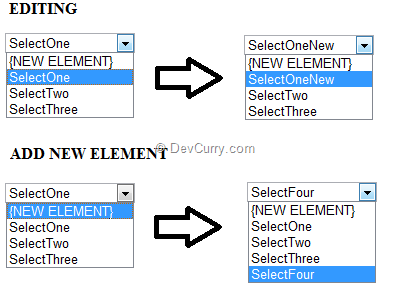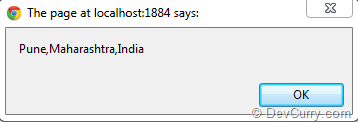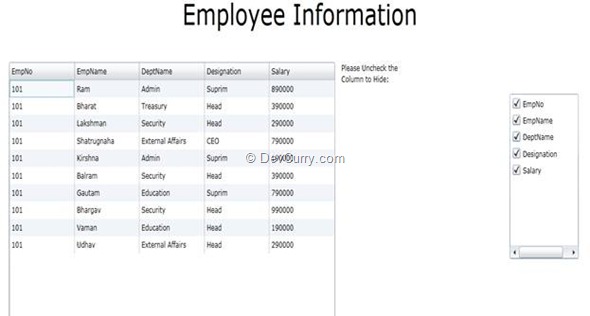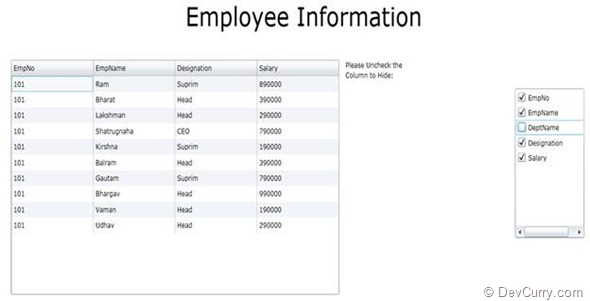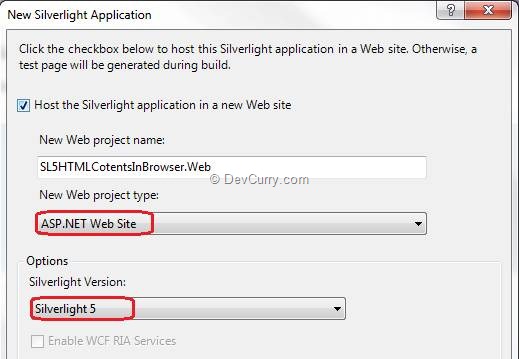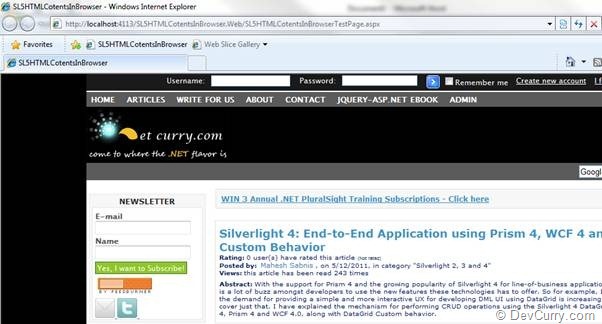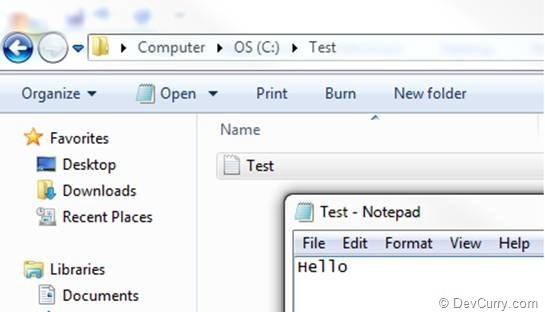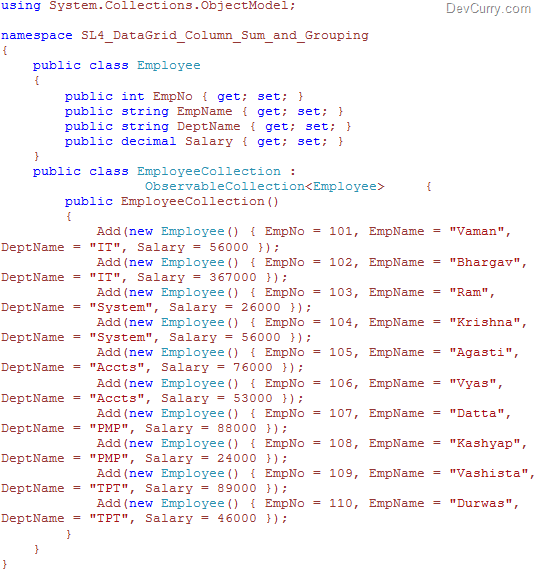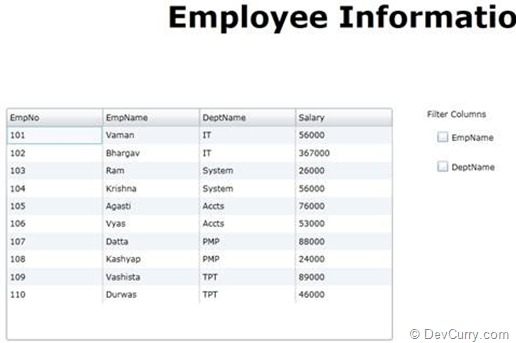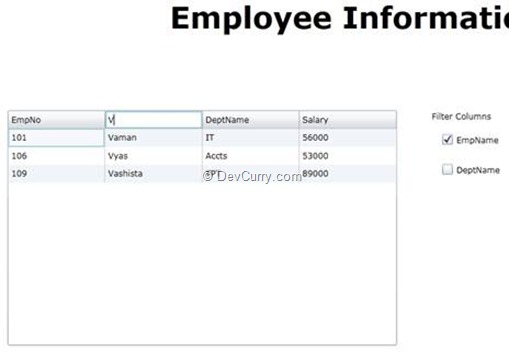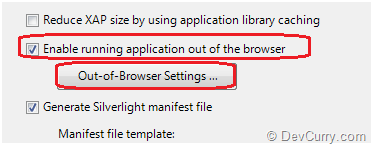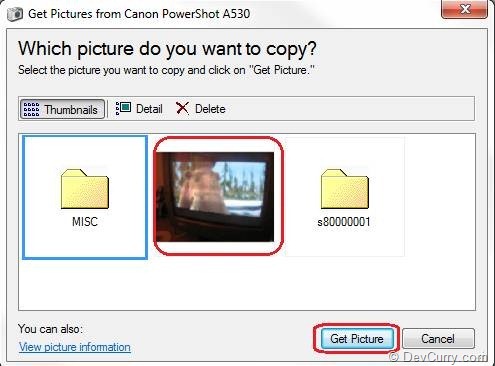Here’s a quick wrap up of jQuery, WPF, Silverlight, SharePoint and other .NET articles published on DevCurry.com in the month of May 2011.
jQuery and JavaScript Articles
JavaScript: Recursive Anonymous Function - I recently saw a question on the forums – How to make a JavaScript anonymous function refer to itself? In other words, how to make an anonymous function in JavaScript call itself from within itself.
Extract Object Values using ECMAScript 5 methods - I find the Object.keys method on ECMAScript 5 extremely useful to return an array containing enumerable properties on a given object. I had a JavaScript object and wanted to extract the values of the object in the shortest possible way.
String as Read-only Arrays in JavaScript - During a tech gathering, we were discussing how String acts as a read-only array in JavaScript in the latest browsers. Many of the developers did not know about this, so I thought to write a short post on the same.
Parsing XML using jQuery - I was recently asked if there was a simple way to parse XML using jQuery. My answer was I would always prefer serializing my data to JSON and then read it using jQuery. However if you do not have that option available for some reason, here’s a simple example of reading an XML document using jQuery
jQuery: Editable Combo Box - I stumbled across a cool jQuery plugin that allows you to have editable combo box (HTML Select element). Using this plug-in, you can add, remove and edit items from the list
jQuery 1.6 Released - The jQuery team recently announced the release of version 1.6. This latest version boosts performance as the team has rewritten the way jQuery handles HTML attributes. Event Handlers now perform better, so do animations, with the introduction of a timer that can sync multiple animations to the same timer interval. There are many bug fixes as well
Silverlight and WPF articles
WPF 4: Using DataGrid Context-Menu for Performing Insertion and Deletion Operations - In most cases, when you develop WPF UI application with the DataGrid control, end-users demand Excel like features with various shortcuts for performing Insert and Delete operations. The WPF DataGrid Context Menu helps us to develop similar kind of UI applications.
WPF 4: Using Input Bindings to Go Mouseless - While creating the UI of an application, we need to adopt techniques that makes the user comfortable with the app. If the existing user is habitual of using shortcut keys for various operations, then while developing the new user interface, it is necessary for the UI developer to provide a similar functionality. In WPF, we have such a facility using ‘InputBindings’.
Silverlight 4: Nested DataGrid for Master-Details Scenarios - The Silverlight DataGrid is a very commonly used control for displaying huge amounts of data. Similarly to save screen space and display Master-Details scenarios, a Nested DataGrid is recommended.
Silverlight 4 and COM: Sending Mails Using Outlook - In this post we will see how to access Microsoft Outlook for sending an Email using Silverlight and COM object.
Silverlight 4: Convert Text to Speech - In this post, we will see how to use Silverlight and COM to convert text into speech. We will be using the the ‘SAPI.SpVoice’ API.
Access Camera using Silverlight 4.0 and COM - In this post, we will see how to access a Camera using Silverlight 4.0 Out-Of-Browser and COM.
Silverlight 4 DataGrid Filtering using DataGridColumnStyle - In Silverlight 4, the DataGrid control provides many features for effective data representation. I must say that most of the end-user’s requirements for Tabular Data representation and interaction can be easily accomplished using the DataGrid control.
Silverlight 5 Beta – Unrestricted File Access in Browser - In this post, we will explore Silverlight 5 Beta unrestricted file access within a browser with elevated trust.
Enterprise Library 5 for Silverlight - Silverlight Integration Pack for Enterprise Library is a collection of guidance and reusable application blocks designed to assist Silverlight application developers with common LOB development challenges.
Silverlight 5 Beta - WebBrowser Control In Browser to Display HTML - In this post, we will see how to use WebBrowser control to display HTML contents in browser using Silverlight 5 beta. In Silverlight 4, we can use the WebBrowser control only in 'Out-Of-Browser' applications.
Silverlight 4: Hide/Unhide DataGrid Columns - Silverlight DataGrid is a nice control provided for Data representation as well as manipulation. Since this control provides its object model separately e.g. DataGridColumn, DataGridColumnHeader etc, it is very easy for us to provide custom data representation capability to this control.
.NET and SharePoint Articles
ASP.NET 4 Granular View State - In this post, we will see how to control a view state at Page level as well as Control level.
Windows Phone 7 applications with SharePoint 2010 Products - Microsoft has released a cool whitepaper that describes how to build Windows Phone 7 applications with SharePoint 2010 Products and Microsoft Forefront Unified Access Gateway (UAG).
.NET - Start Asynchronous Parallel Task and Cancel Them Too - I was having a good discussion with a couple of friends about the support of parallel tasks in .NET. If you too are interested in the same, I have written a couple of articles that can give you an overview of the support for parallelism and concurrency in .NET applications.
Technical Documents for Microsoft SharePoint Server and Foundation 2010 - Microsoft has released two documents that includes technical information about the Microsoft SharePoint Server and Foundation 2010 provider for Windows PowerShell and other helpful reference information about general settings, security, and tools.
Remove all Lower Case Letters using C# - I came across a discussion where the OP wanted to use only the first letter of a word in a string. The first letter of each word was capitalized, so his requirement was to abbreviate the sentence by removing all lower case letters in a string
SharePoint 2010 Performance and Capacity Recommendation - Microsoft has released a series of SharePoint whitepapers and articles that contains information about the performance and capacity characteristics of each SharePoint feature and how it was tested by Microsoft.
Other Articles
Visual Studio Async CTP (SP1 Refresh) - For those who are new to Visual Studio Async, it extends Visual Studio 2010 and provides streamlined syntax for asynchronous development in C# and Visual Basic.
Test Websites in Different IE Browser Versions - If you have a requirement of testing your websites in older versions of Internet Explorer, Microsoft has provided VHD’s (Virtual Hard Disk) with Windows set up with the specified version of Internet Explorer. Here’s the list
Windows Phone 7 ‘s Next Release called Mango announced –Important Links - Microsoft announced the next release of Windows Phone 7 – code named Mango. The primary focus of this Beta release has been app centric multitasking (partial), IE9 Webbrowser controls (HTML 5 support comes in naturally), Silverlight 4 and XNA support, additional sensors, Direct camera access, VB.NET support, Local SQL DB, and more.
Office 2011 for Mac: Free Training - If you are using Office 2011 for Mac or plan to do so, then here’s some free training material for you to get up and started with Office 2011. Microsoft has released a set of training downloads (.pdf) and PowerPoint (.pptx) slides of all Office 2011 tutorials and videos.
Win .NET EBooks and PluralSight Training in this GiveAway - My other site DotNetCurry.com is doing a GiveAway to celebrate it’s 4 year on the web. There are 156 prizes consisting of .NET Books, Software and Training and you can win them too!!




![clip_image002[6] clip_image002[6]](http://lh3.ggpht.com/-zo29HGBpHt0/TeMc9J6vybI/AAAAAAAAAZg/rdh0-tTYJQo/clip_image002%25255B6%25255D%25255B2%25255D.jpg?imgmax=800)







